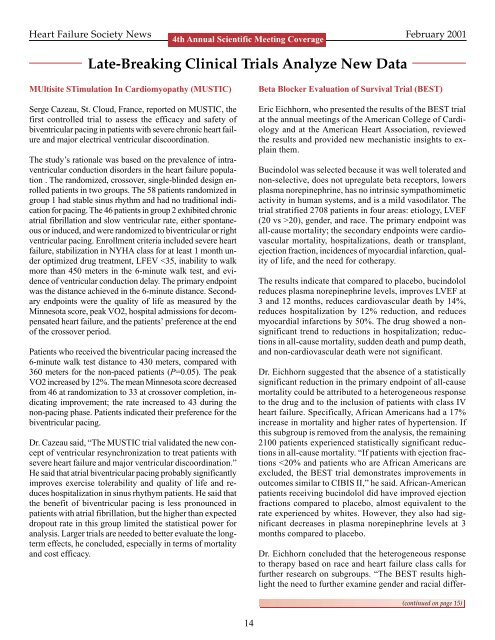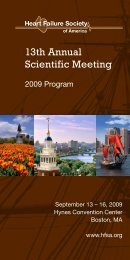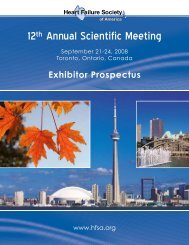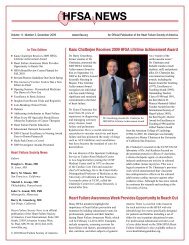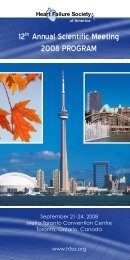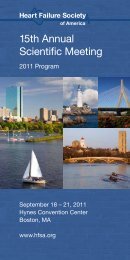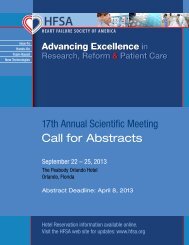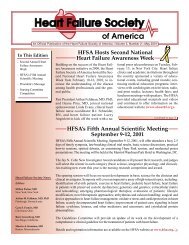Volume 3, Number 1 - Heart Failure Society of America
Volume 3, Number 1 - Heart Failure Society of America
Volume 3, Number 1 - Heart Failure Society of America
You also want an ePaper? Increase the reach of your titles
YUMPU automatically turns print PDFs into web optimized ePapers that Google loves.
<strong>Heart</strong> <strong>Failure</strong> <strong>Society</strong> News February 2001<br />
4th Annual Scientific Meeting Coverage<br />
Late-Breaking Clinical Trials Analyze New Data<br />
MUltisite STimulation In Cardiomyopathy (MUSTIC)<br />
Serge Cazeau, St. Cloud, France, reported on MUSTIC, the<br />
first controlled trial to assess the efficacy and safety <strong>of</strong><br />
biventricular pacing in patients with severe chronic heart failure<br />
and major electrical ventricular discoordination.<br />
The study’s rationale was based on the prevalence <strong>of</strong> intraventricular<br />
conduction disorders in the heart failure population<br />
. The randomized, crossover, single-blinded design enrolled<br />
patients in two groups. The 58 patients randomized in<br />
group 1 had stable sinus rhythm and had no traditional indication<br />
for pacing. The 46 patients in group 2 exhibited chronic<br />
atrial fibrillation and slow ventricular rate, either spontaneous<br />
or induced, and were randomized to biventricular or right<br />
ventricular pacing. Enrollment criteria included severe heart<br />
failure, stabilization in NYHA class for at least 1 month under<br />
optimized drug treatment, LFEV 20), gender, and race. The primary endpoint was<br />
all-cause mortality; the secondary endpoints were cardiovascular<br />
mortality, hospitalizations, death or transplant,<br />
ejection fraction, incidences <strong>of</strong> myocardial infarction, quality<br />
<strong>of</strong> life, and the need for cotherapy.<br />
The results indicate that compared to placebo, bucindolol<br />
reduces plasma norepinephrine levels, improves LVEF at<br />
3 and 12 months, reduces cardiovascular death by 14%,<br />
reduces hospitalization by 12% reduction, and reduces<br />
myocardial infarctions by 50%. The drug showed a nonsignificant<br />
trend to reductions in hospitalization; reductions<br />
in all-cause mortality, sudden death and pump death,<br />
and non-cardiovascular death were not significant.<br />
Dr. Eichhorn suggested that the absence <strong>of</strong> a statistically<br />
significant reduction in the primary endpoint <strong>of</strong> all-cause<br />
mortality could be attributed to a heterogeneous response<br />
to the drug and to the inclusion <strong>of</strong> patients with class IV<br />
heart failure. Specifically, African <strong>America</strong>ns had a 17%<br />
increase in mortality and higher rates <strong>of</strong> hypertension. If<br />
this subgroup is removed from the analysis, the remaining<br />
2100 patients experienced statistically significant reductions<br />
in all-cause mortality. “If patients with ejection fractions<br />


